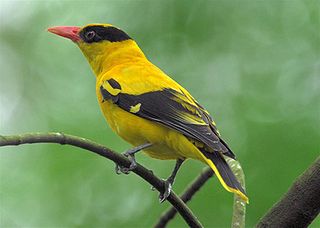 W
WOrioles are colourful Old World passerine birds in the genus Oriolus, the namesake of the corvoidean family Oriolidae. They are not related to the New World orioles, which are icterids that belong to the superfamily Passeroidea.
 W
WThe African golden oriole, or African oriole, is a member of the oriole family of passerine birds which is a resident breeder in Africa south of the Sahara desert.
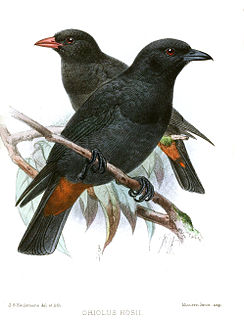 W
WThe black oriole is a species of bird in the family Oriolidae. It is endemic to the island of Borneo. One of the least known of the orioles, its distribution range is restricted to Sarawak in Borneo. Along with the black-and-crimson, maroon, and silver orioles, it belongs to a clade of red and black orioles. The binomial name is after Charles Hose who collected the first specimen of the species on Mount Dulit.
 W
WThe black-and-crimson oriole is a species of bird in the family Oriolidae.
 W
WThe black-eared oriole, or Buru oriole, is a species of bird in the family Oriolidae. It is native to Buru island.
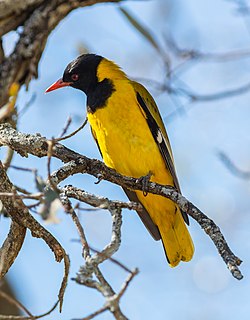 W
WThe black-headed oriole is a species of bird in the family Oriolidae. It is found in Africa and has a very striking appearance with a bright yellow body, contrasting black head and flesh-coloured beak.
 W
WThe black-hooded oriole is a member of the oriole family of passerine birds and is a resident breeder in tropical southern Asia from India and Sri Lanka east to Indonesia.
 W
WThe black-naped oriole is a passerine bird in the oriole family that is found in many parts of Asia. There are several distinctive populations within the wide distribution range of this species and in the past the slender-billed oriole was included as a subspecies. Unlike the Indian golden oriole which only has a short and narrow eye-stripe, the black-naped oriole has the stripe broadening and joining at the back of the neck. Males and females are very similar although the wing lining of the female is more greenish. The bill is pink and is stouter than in the golden oriole.
 W
WThe black-winged oriole is a species of bird in the family Oriolidae. It is found in Africa from Sierra Leone and Liberia to southern South Sudan, western Uganda, central Democratic Republic of Congo and north-western Angola.
 W
WThe brown oriole is a species of bird in the family Oriolidae.
 W
WThe dark-throated oriole is a species of bird in the family Oriolidae.
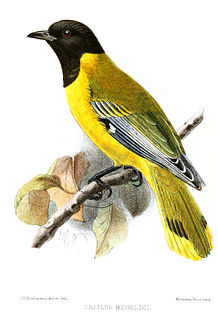 W
WThe Ethiopian oriole is a species of bird in the family Oriolidae.
 W
WThe Eurasian golden oriole also called golden oriole, is the only member of the Old World oriole family of passerine birds breeding in Northern Hemisphere temperate regions. It is a summer migrant in Europe and Palearctic and spends the winter season in central and southern Africa.
 W
WThe green oriole or Australasian yellow oriole, is an inconspicuous inhabitant of lush tropical vegetation throughout Australia and New Guinea.
 W
WThe green-headed oriole, or montane oriole, is a species of bird in the family Oriolidae. It is found in eastern Africa.
 W
WThe grey-collared oriole, or Seram oriole, is a species of bird in the family Oriolidae. It is endemic to Seram.
 W
WThe Indian golden oriole is a species of oriole found in the Indian subcontinent and Central Asia. The species was formerly considered to be a subspecies of the Eurasian golden oriole, but is now considered a full species. Adults can be told apart from the Eurasian golden oriole by the black of the eye stripe extending behind the eye.
 W
WThe Isabela oriole is a species of the oriole family endemic to Luzon in the Philippines. The bird was presumed to be extinct for many years until its rediscovery in December 1993 near Diffun, Quirino, and in Mansarong in September 1994. Additional sightings were made in San Mariano, Isabela. and Baggao, Cagayan Valley It It is found in moist lowland forest up to 440 masl. It is threatened by habitat loss and hunting.
 W
WThe maroon oriole is a species of bird in the family Oriolidae. It is found in Southeast Asia.
 W
WThe dark-throated oriole is a species of bird in the family Oriolidae.
 W
WThe olive-backed oriole, or white-bellied oriole, is a very common medium-sized passerine bird native to northern and eastern Australia and south-central New Guinea. The most wide-ranging of the Australasian orioles, it is noisy and conspicuous.
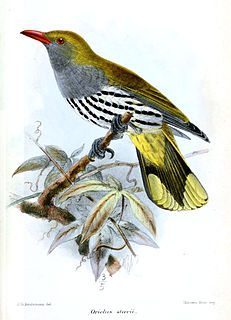 W
WThe Philippine oriole or grey-throated oriole, is a species of bird in the family Oriolidae. It is endemic to the Philippines.
 W
WThe São Tomé oriole, or great-billed oriole, is a species of bird in the family Oriolidae. The species was named by Gustav Hartlaub in 1857. It is endemic to the island of São Tomé. Its natural habitats are subtropical or tropical moist lowland forests and subtropical or tropical moist montane forests. It is threatened by habitat loss.
 W
WThe silver oriole is a species of bird in the family Oriolidae. It breeds in southern China and winters in mainland Southeast Asia.
 W
WThe slender-billed oriole is a species of bird in the family Oriolidae found from the eastern Himalayas to Southeast Asia.
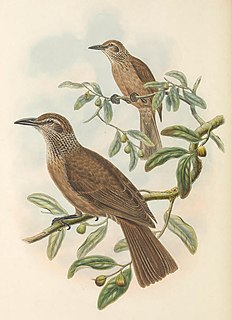 W
WThe Tanimbar oriole is a species of bird in the family Oriolidae. It is endemic to the Tanimbar Islands.
 W
WThe Timor oriole is a species of bird in the family Oriolidae. It is endemic to the Lesser Sundas, where it is found on Timor, Rote and Semau Islands. Its natural habitats are subtropical or tropical dry forests and subtropical or tropical mangrove forests.
 W
WThe western oriole, or western black-headed oriole, is a species of bird in the family Oriolidae that is native to Africa. The adult upperparts are yellow-olive, and the underparts are yellow in colour. It is rated as a species of least concern on the International Union for Conservation of Nature Red List of Endangered Species.
 W
WThe Wetar oriole is a species of bird in the family Oriolidae. It is endemic to the Lesser Sundas, where it is found on Wetar and Atauro Islands. Its natural habitats are subtropical or tropical dry forests and subtropical or tropical mangrove forests.
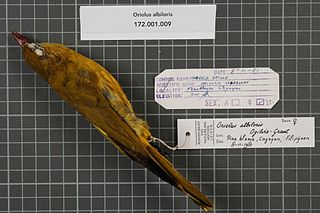 W
WThe white-lored oriole is a species of bird in the family Oriolidae.